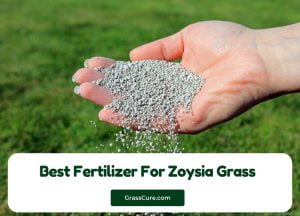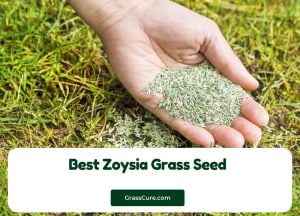If your lawn looks a little lacklustre, it might be time to give it a nutrient boost. Fertilizing your grass can help it green up and look its best. And when it comes to fertilizing zoysia grass, there are a few things you need to keep in mind.
Zoysia grass is a relatively low-maintenance grass that does well in warm climates. But to keep it looking its best, you’ll need to fertilize it occasionally. Before the grass proliferates, the best time to fertilize zoysia is in the spring. You can use a pre-emergent fertilizer or a balanced fertilizer such as 10-10-10.
Be sure to water your lawn well after you fertilize it. Zoysia grass is a relatively drought-tolerant grass, but it will need water to help the fertilizer penetrate the soil. You should also avoid mowing your lawn for a few days after fertilizing, so the fertilizer can work its magic.
Now that you know how to fertilize zoysia grass, your lawn will be looking its best in no time!
Contents
How do you know you need to fertilize zoysia grass?
In early spring, midsummer, and autumn, Zoysia grass needs to be fertilized two or three times a year. Signs that your zoysia grass may need fertilizer include yellowing the leaves, thinning the turf, lack of vigour, and slow growth. You can also perform a soil test to check the levels of nutrients in your soil.
The best time to fertilize zoysia grass is actively growing in early spring, midsummer, or autumn. Fertilizers are available in either granular or liquid form. When choosing a fertilizer, be sure to read the label to make sure it’s appropriate for use on zoysia grass.
Granular fertilizers are easy to apply. You can either spread them evenly over the entire lawn using a fertilizer spreader, or you can place them in spots where the zoysia grass is thinning.Liquid fertilizers can be applied with a garden hose or watering can. Be sure to read the manufacturer’s instructions on using the fertilizer.
Zoysia grass doesn’t need a lot of fertilizer. A general rule of thumb is to apply 1/2 pound of nitrogen per 1,000 square feet of lawn. For example, if your lawn is 5,000 square feet, you need to use 2.5 pounds of nitrogen.
Applying too much fertilizer will cause the zoysia grass to grow too quickly. This can lead to thinning of the turf and yellowing of the leaves. It’s also a waste of money, as you’ll end up using more fertilizer than necessary.
If you’re unsure how much fertilizer to apply, it’s better to err on the side of caution and use less than you think you need. You can always add more fertilizer if the zoysia grass isn’t showing signs of growth.
When applying fertilizer, be sure to follow the manufacturer’s instructions on how often to fertilize and how much to use. Applying too much fertilizer can harm the zoysia grass.
What Type of Fertilizer Does Zoysia Grass Need?
Zoysia grass is a type of grass that is common in the southern United States. It is a warm-season grass that goes dormant during the winter. Zoysia grass needs regular fertilization to stay healthy and look its best. The type of fertilizer you use will depend on the kind of zoysiagrass you have.
Nitrogen is the essential nutrient for zoysia grass. It is responsible for the green colour of the grass and for promoting growth. A balanced fertilizer that contains nitrogen, phosphorus, and potassium will be adequate for zoysia grass. You can find these fertilizers at most garden stores.
In general, you should fertilize your zoysia grass twice a year, once in the spring, when the grass begins to grow, and again in the summer. Follow the directions on the fertilizer package to determine how much to use. After you fertilize it, be sure to water the lawn to help the fertilizer soak in.
If your zoysia grass is not doing well, you may need to fertilize it more often. A soil test can help you determine if your grass lacks nutrients. Contact your local cooperative extension office for more information about soil testing.
5 recommended fertilizers for zoysia grass:
- Lesco.
- Ironite.
- Milorganite.
- Scotts Turf Builder.
- Espoma Lawn Food.
When it comes to fertilizing zoysia grass, you have a few different options to choose from. Lesco is a popular choice among many homeowners, as it is a slow-release fertilizer that helps to improve the overall look of the lawn.
Ironite is another good option for fertilizing zoysia, as it is high in iron and can help to green up the lawn quickly. Milorganite is also a popular choice, as it is organic and helps to improve soil health over time. Scotts Turf Builder is an excellent all-purpose fertilizer that can be used on zoysia grass, and Espoma Lawn Food is an organic option that is safe for use around children and pets.
FAQ:
Best time of year to fertilize zoysia grass?
The best time to fertilize zoysia grass is in the early spring and late fall. For best results, two applications should be made per year. The first application should be made in early spring, just as the grass begins to green up. The second application should be made late fall after the grass has gone dormant for the winter. Fertilizer should be spread evenly over the entire lawn, using either a broadcast spreader or a rotary spreader.
Can you use Scotts turf Builder on Zoysia grass?
The short answer is yes. You can use Scotts Turf Builder on zoysia grass. However, it’s important to note that you should only use a fertilizer designed explicitly for zoysia grass, as using the wrong type of fertilizer can harm your lawn.
Can Zoysia grass be grown from seed?
The key to growing from zoysia grass seed is to use fresh, high-quality seeds and to plant them in well-prepared soil. Zoysia grass is a warm-season grass, so it will not germinate or grow well in cold weather.
If you live in a colder climate, you may need to start the seeds indoors and transplant them to the garden later in the season. Zoysia grass is fairly drought-tolerant, so it does not require a lot of water once it has been established.
However, it is important to water zoysia grass regularly during the first few weeks after planting to help the grass get established. Zoysia grass can be mowed at a height of 3-4 inches, and it will continue to grow until it is frozen out of the ground.
Zoysia is a good choice for a lawn in areas that experience high traffic because it is durable and tolerant of wear and tear. Zoysia grass will go dormant in the winter, so it will not need to be mowed during this time.
Conclusion:
After reading this article, you should better understand how to fertilize zoysia grass. Remember that following the manufacturer’s instructions is essential when applying fertilizer to your lawn. Using too much or too little fertilizer can damage your grass. If you have any questions about fertilizing your zoysia grass, be sure to ask a professional lawn care expert.



